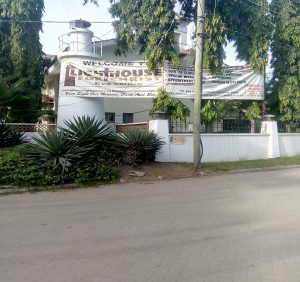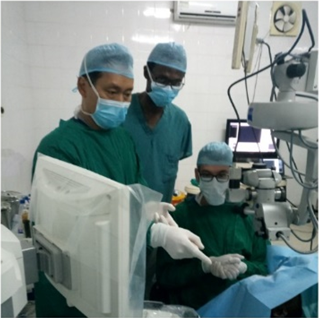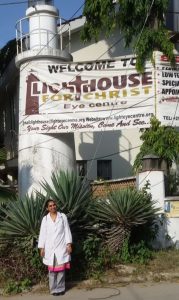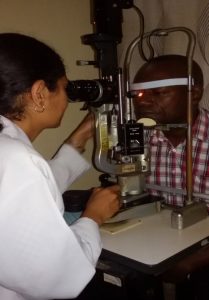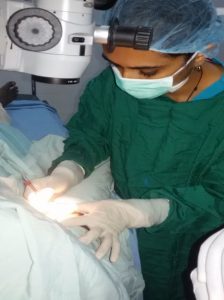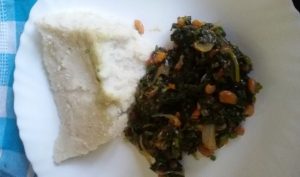Post by W’mosi Brenda Achieng, an Ophthalmology resident at University of Nairobi Faculty of Medicine (Kenya) who completed a elective exchange at Lighthouse for Christ Eye Centre through the GEMx-COESCA Regional Exchange Partnership
Ophthalmology Elective Experience
In my second year as an ophthalmology resident I had the opportunity to do my first elective term. I chose to do it at Lighthouse for Christ Eye Centre and applied through GEMx.
Traveling:
I flew to Mombasa early in the morning. The airplane ride was short and comfortable. I had booked the ticket two weeks in advance so I bought the ticket at a good rate. I would advice anyone who wants to fly there to buy the tickets online way in advance as they are a lot cheaper as compared to purchasing them a few days to the journey. I took an uber from the airport to the hospital.
Weather:
The weather there is generally hot and humid. It is advisable to carry lots of light clothes and some sunscreen. There were occasional rainy periods during my stay but the rainfall was quite light.
Arrival and stay:
I arrived and went to report at the hospital. I met the Medical Director who is also a Cornea specialist.
He gave me a quick orientation and introduced me to all the staff. He gave me an overview of the values and mission of the hospital and communicated what was expected of me during my elective period.
I was informed on work attire and would put on my white coat on top of my clothes or wear scrubs. I would advise on putting on scrubs to work as they were comfortable and easy to work in the hot weather.
Everyone was very welcoming and friendly. I had no doubt that I would feel at home away from home. He gave me the afternoon off to go and settle myself at my accommodation as I was to stay at a nearby flat outside the hospital for the first 3 weeks.
After 3 weeks I moved into the hospital accommodation. It was a quite a big room, with a bed, fan, fast Wi-Fi and a set of sofas. It was self-contained with a shower and toilet. The kitchen was however adjacent to it with its own key. The kitchen was clean and had a table top cooker and gas. Utensils were also provided in the kitchen.
Work experience:
My first day was in the general clinic which runs every day. The clinic is usually very busy. There was a visiting consultant from Japan who is an anterior segment specialist. Together with him and the medical director, we were able to see about 100 patients on day 1. Some of the other clinic staff were on an outreach in another county doing free cataract surgeries in the community.
I was able to attend the other clinics which run concurrently with the other clinics on specific days. I attended some of the cornea clinics which would run on Tuesdays. I also attended some of the Wednesday clinics which were paediatric ophthalmology clinics. Main theatre days are on Mondays, Wednesdays and Thursdays. I was able to review challenging and interesting cases with the medical director who was always available for consultation. I also managed to review interesting paediatric ophthalmology cases with the paediatric ophthalmologist. I also learnt a lot from the other cadres at the hospital. Apart from the ophthalmologists, there are also two ophthalmic clinical officers two ophthalmic nurses, and other cadres. Everyone was willing to teach and also learn something from the other.
At Lighthouse for Christ Eye Centre, there are visiting ophthalmologists from time to time. They are from various countries and different sub specialties. Apart from getting to work with the Anterior segment consultant from Japan for a week, I also got to meet and work with a visiting Cornea specialist from India. Together with the medical director and the visiting cornea specialist, I was able to review patients with them and learn a lot over the few days.
I also managed to learn a lot surgically. I did my first complete cataract surgery and managed to do 13 cataract surgeries. I was also able to learn and do other procedures like 3 excisions of pterygiums and conjunctival masses. I learnt how to excise chalazions and also how to do punctum repair when doing a lid laceration repair, and also learnt how to do YAG-capsulotomy. There are also Continuous Medical Education seminars every last Friday of the month. I was able to attend 3 seminars during my stay at the hospital which were very informative.
Day to day living:
I would cook most of my meals in the kitchen. However, at lunchtime, I sometimes would buy meals at an affordable price at the hospital canteen. The meals sold there are balanced and healthy with fresh ingredients. Price range was about ksh50-100 for a full meal. For fresh vegetables, there is a market not too far away in town where one can access fresh raw ingredients. The hospital and the central business district are very close to each other. About 5-10 minutes away from each other. I had access to the supermarkets, ATMs and banks as they were just a few minutes away. My main means of getting around were ‘Tuk-tuks’ and ‘matatus’ for nearby places as well as Uber taxis for the places that were far. Most means of transport were affordable and convenient.
For some of the cultural dishes, there are many hotels that serve the authentic coastal dishes that were affordable and a walking distance from the hospital
I did my own laundry and there is a good outdoor hanging line.
Security within the hospital was very good and it is round the clock. Both the room and kitchen had padlocks. In case of emergencies, there was an alarm within the room as well as an indoor phone which you could contact the other residences within the hospital or the main hospital block. The security officers were always courteous and willing to help in case of anything.
There are also many tourist sites that one may visit over weekends when free. For example, there are some tourist sites not too far from the hospital for example Fort Jesus. There are many beaches as well as the marine park just to mention a few.
Religion:
Lighthouse for Christ Eye Centre is very tolerant of all religions despite being a Christian institution.
It serves a community which has Christians, Muslims, Buddhists among others. All patients are treated equally and with respect regardless of religion, race and socio-economic status.
There was devotion twice a week, on Tuesday mornings and Friday mornings at 7.15 am -8 am which I attended. All staff were welcome and the sessions were always spiritually uplifting.
Overall:
My overall experience was great. The work experience was different and very interesting. I got to work with different people and cadres. The staff at Lighthouse were hardworking and professional as well as very warm. Learning was both ways and I learnt a lot from everyone. I was exposed to so many different conditions from which I learnt a lot in terms of management and surgeries. I was able to perform surgeries under supervision and my teachers were patient.
I am grateful to GEMx for granting me this great opportunity. It was invaluable in my training in ophthalmology. I would not trade that experience for anything.


